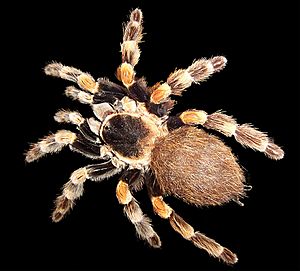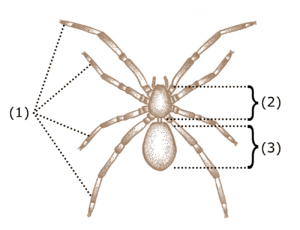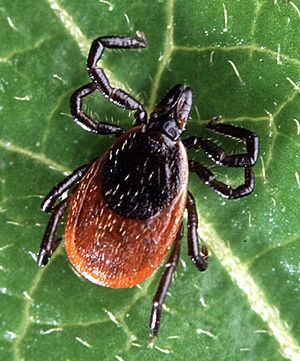Arachnid facts for kids
Quick facts for kids Arachnids |
|
|---|---|
 |
|
| A spider | |
| Scientific classification | |
| Kingdom: | |
| Phylum: | |
| Subphylum: | |
| Class: |
Arachnida
|
Arachnids are a group of eight-legged arthropods. This means they are invertebrates (animals without a backbone) with a hard outer shell and jointed legs.
This successful group includes many animals you might know. Some common arachnids are spiders, scorpions, harvestmen, ticks, and mites. There are also several smaller, less known groups.
Contents
Arachnid Body Parts
Almost all adult arachnids have eight legs. This is a key way to tell them apart from insects, which have six legs.
Arachnids also have two other pairs of body parts near their mouth. These are used for eating, defending themselves, and sensing the world.
- The first pair are called chelicerae. They help with feeding and defense.
- The second pair are called pedipalps. These can help with eating, moving around, or even with reproduction.
Like all arthropods, arachnids have a hard outer shell called an exoskeleton. This shell acts like armor, protecting their bodies. They also have some internal support, like a cartilage-like tissue, where certain muscles attach.
Arachnids do not have antennae (feelers) or wings. Their body is split into two main sections:
- The cephalothorax: This is the front part, where the head and chest are joined. Their legs are attached here.
- The abdomen: This is the back part of their body.
How Arachnids Breathe
Arachnids have special ways to breathe on land. They have internal breathing surfaces, meaning their breathing parts are inside their bodies.
These breathing parts can be:
- trachea: These are small tubes that carry air directly to their tissues.
- 'Book lungs': These are like modified gills. They are internal, folded structures that look a bit like the pages of a book. Air passes over these folds, allowing the arachnid to take in oxygen.
What Arachnids Eat
Most arachnids are carnivorous, meaning they eat meat. They usually feed on insects and other small animals. They often eat prey that has already been partly digested. This helps them avoid getting internal parasites.
Only a few arachnids, like harvestmen and some mites, can eat solid food. Many arachnids can make venom in special glands. They use this venom to kill their prey or protect themselves from enemies.
Some mites are external parasites. This means they live on the outside of other animals. Some of these mites can even carry diseases, acting as vectors.
How They Digest Food
After killing their prey, arachnids pour special digestive juices from their stomachs onto it. These juices quickly turn the prey into a liquid 'broth' of nutrients.
The arachnid then sucks this liquid into a small space in front of its mouth. Behind the mouth is a strong, muscular tube called a pharynx. This pharynx acts like a pump, sucking the food through the mouth and into the oesophagus and then the stomach. In some arachnids, the oesophagus also helps pump the food.
How Arachnids Sense the World
Arachnids have different ways to sense their surroundings.
Arachnid Eyes
Arachnids have two main types of eyes:
- Lateral ocelli: These eyes developed from compound eyes (like those found in insects). They sometimes have a special layer called a tapetum lucidum. This layer helps them collect more light, especially in dim conditions. Most arachnids have no more than three pairs of these eyes, but scorpions can have up to five pairs.
- Median ocelli: These eyes develop differently.
The ancestors of modern arachnids probably had both types of eyes. However, many modern arachnids have lost one type or the other.
The clear outer part of the eye, called the cornea, also acts as a lens. It is connected to the body's outer shell. Beneath the cornea is a clear, jelly-like part, then the retina (the light-sensing part), and sometimes the tapetum. For most arachnids, their eyes likely don't have enough light-sensing cells to form a clear image.
Other Sensory Organs
Besides their eyes, almost all arachnids have two other important types of sensory organs:
- Sensory hairs: Fine hairs cover their bodies. These hairs give the arachnid its sense of touch. Some are simple, but many arachnids also have more complex hairs called trichobothria.
- Slit sense organs: These are tiny, slit-like pits covered with a thin membrane. Inside the pit, a small hair touches the membrane. When the membrane moves, the hair detects it. Scientists believe these organs help arachnids know where their body parts are (called proprioception) and possibly even help them hear.
The Myth of Arachne
The word Arachnida comes from the Greek word for 'spider'. There's a famous Greek legend about a girl named Arachne.
Arachne was a very skilled weaver. She boasted that she could win a weaving contest against the goddess Athena. Arachne did win the contest, but Athena became very angry. She turned Arachne into a spider because of her hubris (meaning extreme pride) in challenging a goddess.
Types of Arachnids
There are many different kinds of arachnids, grouped into various orders. Here are some of the main ones:
- Araneae (spiders): There are over 40,000 species of spiders!
- Mesothelae: These are very rare, ancient spiders with a segmented abdomen.
- Opisthothelae: Most spiders belong to this group. Their abdomen is not segmented.
- Araneomorphae: These are the most common spiders you see.
- Mygalomorphae: This group includes tarantulas and similar spiders.
- Acarina (mites and ticks): Over 30,000 species.
- Acariformes
- Sarcoptiformes
- Trombidiformes
- Opilioacariformes
- Parasitiformes: This group includes ticks and some mites.
- Acariformes
- Opiliones (harvestmen or daddy-long-legs): About 6,300 species.
- Scorpiones (scorpions): Around 2,000 species.
- Pseudoscorpionida (pseudoscorpions): About 3,000 species.
- Solifugae (windscorpions, sun spiders, or camel spiders): Around 900 species.
- Amblypygi ("blunt rump" tailless whip scorpions): These have front legs that look like whips and can be very long (25 cm or more). About 140 species.
- Palpigradi (microwhip scorpions): About 80 species.
- Ricinulei (hooded tickspiders): About 60 species.
- Schizomida ("split middle" whip scorpions): These have divided exoskeletons. About 220 species.
- Thelyphonida (vinegarroons or whip scorpions): These have front legs modified for sensing and a long tail at the end of their abdomen. About 100 species.
Images for kids
-
"Arachnida" from Ernst Haeckel's Kunstformen der Natur, 1904
See also
 In Spanish: Arácnidos para niños
In Spanish: Arácnidos para niños









